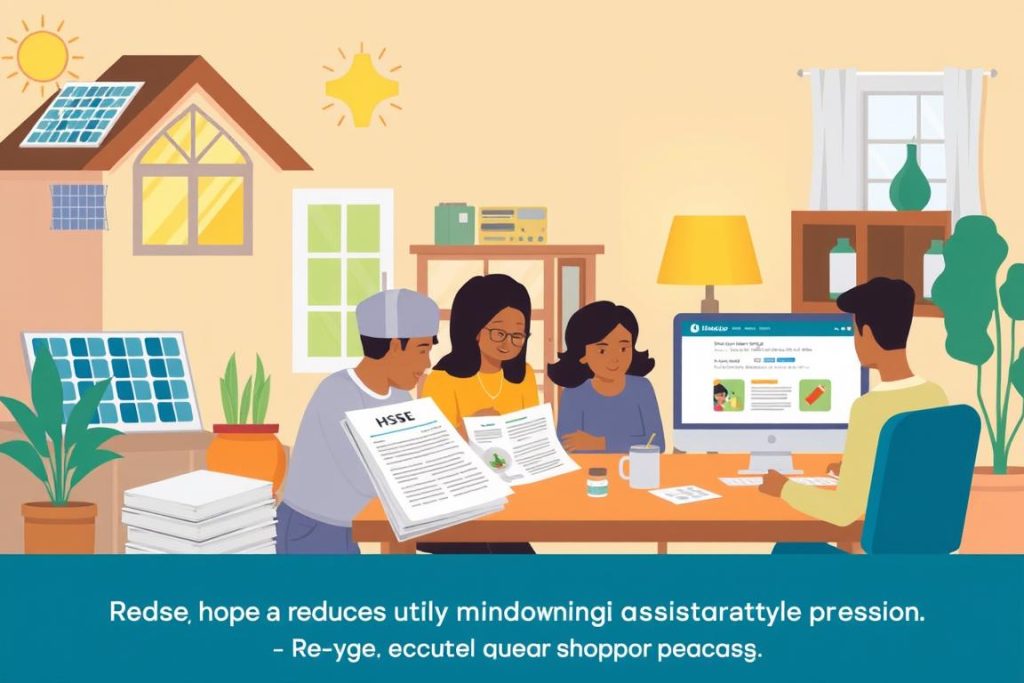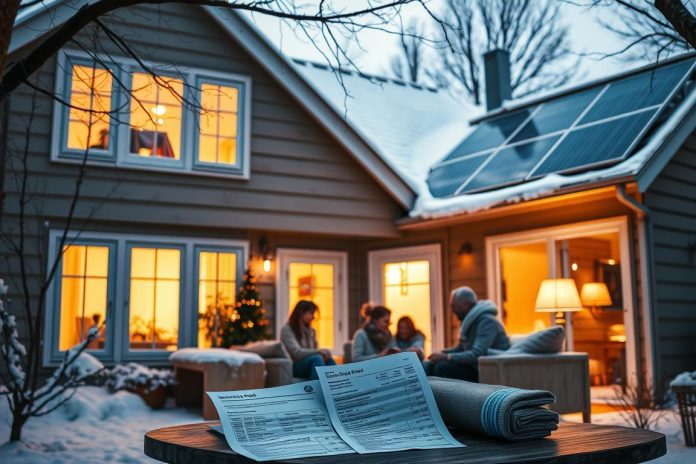When winter’s chill or summer’s heat hits, we all want a warm, cozy space. But high utility bills can make this seem out of reach. The Low Income Home Energy Assistance Program (LIHEAP) offers help to those struggling with these costs1. Learning how to apply for LIHEAP and understanding the LIHEAP application process can help reduce your energy bills.
LIHEAP aims to help low-income families not just with bills but also in energy emergencies. It offers weatherization services to make homes safer and more efficient1. Don’t be put off by the application process. The support you need to stay safe and comfortable is within reach.
Key Takeaways:
- The importance of LIHEAP for reducing energy costs for low-income families1.
- Insights into the simple, yet impactful LIHEAP application process.
- State-specific differences in the LIHEAP program and how they may affect you2.
- Key steps on how to apply for LIHEAP to get the assistance you need.
- Preventive measures to avoid LIHEAP-related fraud and protect your entitlements1.
- Understanding the eligibility criteria to ensure you get the assistance for which you qualify2.
Don’t fear your next energy bill. LIHEAP can turn your worry into comfort and security all year long. It also helps guard against scams in the process12.
Understanding the Low-Income Home Energy Assistance Program (LIHEAP)
The Low-Income Home Energy Assistance Program (LIHEAP) stands as a crucial government energy assistance program. It aims to keep low-income households safe, healthy, and with less energy costs. This program improves millions of lives by providing needed help with energy bills.
Defining the LIHEAP Mission: Safety, Health, and Energy Cost Reduction
LIHEAP’s main goal is to help families struggling to pay for home energy. It makes heating and cooling more affordable. This reduces risks to health and safety from not being able to heat or cool homes properly. It mainly helps the elderly, disabled, and families with small kids who suffer most from extreme weather.
What LIHEAP Covers: From Home Energy Bills to Weatherization Services
LIHEAP helps low-income families with heating, cooling bills, and making homes more energy-efficient. This includes weatherization improvements at a low cost. These efforts notably make energy bills lower. Over 7 million homes have received free improvements, averaging around $5,000, reducing their energy use by 10-20%3.
Funding and Administration: Where Does LIHEAP Aid Come From?
The federal government carefully gives out LIHEAP funds to states, territories, and tribal governments. This makes sure money and help are given out fairly. In 2017, LIHEAP got $3.09 billion, showing its wide reach and importance3. Programs like the Residential Energy Assistance Challenge (REACH) show LIHEAP’s dedication by funding unique energy projects3.
| Year | Weatherization Funding | Households Served |
|---|---|---|
| 2009 | $500 million | 80,000+ |
| 2014 | $300 million | 40,000+ |
Identifying Fraud: How to Recognize and Report LIHEAP Scams
Though LIHEAP has many benefits, one must watch out for scams. You should never pay to get LIHEAP help. If asked for fees, report it to the HHS Fraud Hotline right away. This helps stop scams and protects the program’s integrity.
Eligibility and Application Process for LIHEAP
If you’re struggling with high energy bills, learning about LIHEAP’s eligibility criteria is key. The Low-Income Home Energy Assistance Program (LIHEAP) helps eligible families. Let’s see if you qualify and how to apply.
Do You Qualify? Income and Household Criteria for LIHEAP
To be eligible for LIHEAP, your income must be at or below 200% of the federal poverty level4. The income limits depend on your family size. They start at $22,590 for one person and go up to $95,220 for a household of ten5. Adding $8,070 for each additional person allows for larger families5. Being part of federal programs like TANF or SNAP could also make you eligible.
How to Apply for LIHEAP: A Step-by-Step Guide
The way to apply for LIHEAP depends on where you live but usually involves contacting your local LIHEAP office5. You can apply online, by mail, or in-person5. In Pennsylvania, for example, apply from November 4, 2024, to April 4, 2025, for the 2024-2025 season5. It’s important to apply within these dates to get help that ranges from $200 to $1,000 and doesn’t have to be paid back5. Remember to apply every year to keep getting help.
State-Specific Policies and How They Affect Your Utility Assistance
Understanding your state’s LIHEAP policies is important as they can change your eligibility and benefit amount. Sometimes, rules about disconnection notices might differ due to weather, the residents’ ages or disabilities, or the utility companies’ specific rules. These policies protect those in need, especially during tough weather.
Emergency Services: LIHEAP Support During Energy Crisis Situations
In times of emergency, LIHEAP’s emergency services can be crucial. They offer a Winter Emergency Crisis Intervention Program (ECIP) from November to May, with up to $800 available6. During the summer, from June to September, they provide up to $300 to help6. In immediate danger, households can get a response within 10 business days5.
| Season | Program | Period | Maximum Assistance |
|---|---|---|---|
| Winter | ECIP | November to May | $800 |
| Summer | ECIP | June to September | $300 |
The low-income home energy assistance program is crucial for families to handle their energy costs. By knowing the eligibility rules for LIHEAP, understanding the application process, and being aware of state-specific rules, you can get the help you need. If you need assistance, contact your local LIHEAP office or hotline to learn how to apply for LIHEAP.

Conclusion
LIHEAP is key in helping lower utility bills and offering benefits to eligible families. In the U.S., around 6.7 million households benefit from LIHEAP7. This program is crucial for easing energy costs for low-income citizens.
Caregivers getting LIHEAP help also gain from services like SNAP and TANF. This shows the significant impact of applying for LIHEAP8.
Yet, only about 20% of families that could get LIHEAP help do because of limited funds7. Understanding how to apply and who qualifies is very important.
In places like Florida, you can get LIHEAP help up to three times a year. This shows the program’s flexible support7.
Looking to lower your energy bills? Applying for LIHEAP is a good first step. There are other options too, like the Emergency Rental Assistance Program, for those who don’t qualify.
Use these resources to help stabilize your household’s environment. LIHEAP and related programs offer broad support7.
FAQ
What is the Low Income Home Energy Assistance Program (LIHEAP)?
How can LIHEAP assist me in reducing my utility bills?
What are the eligibility criteria for LIHEAP?
How do I apply for LIHEAP?
Can LIHEAP funds be used for any utility bills?
Where does LIHEAP funding come from, and how is it distributed?
How can I recognize and report LIHEAP scams?
What if I am facing an urgent energy crisis, like a utility shutoff?
Are the benefits the same in every state?
Can LIHEAP help with home repairs?
Source Links
- Paying My Energy Bills – https://www.csd.ca.gov/Pages/Assistance-PayingMyEnergyBills.aspx
- Low Income Home Energy Assistance Program (LIHEAP) – https://mcecleanenergy.org/liheap/
- Low-Income Home Energy Assistance Program – https://en.wikipedia.org/wiki/Low-Income_Home_Energy_Assistance_Program
- How to Apply – https://dceo.illinois.gov/communityservices/utilitybillassistance/howtoapply.html
- Apply for the Low Income Home Energy Assistance Program (LIHEAP) – https://www.pa.gov/en/services/dhs/apply-for-the-low-income-home-energy-assistance-program-liheap.html
- Liheap | mydss.mo.gov – https://mydss.mo.gov/utility-assistance/liheap
- A Guide to Low Income Home Energy Assistance Programs – NerdWallet – https://www.nerdwallet.com/article/finance/low-income-energy-assistance-program
- Heat or eat: the Low Income Home Energy Assistance Program and nutritional and health risks among children less than 3 years of age – PubMed – https://pubmed.ncbi.nlm.nih.gov/17079530/

